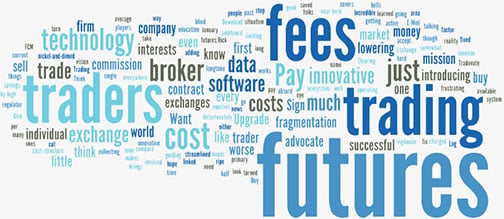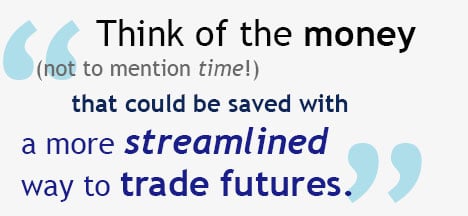
As our name indicates, Tradovate brings innovative technology to traders.
But we’re not being innovative just to be innovative. We’re not adding bells and whistles just to have them. There’s a guiding mission that informs everything we do. That mission is to be a true advocate for the interests of futures traders.
And one area where we feel futures traders need an advocate is in lowering trading costs.
Being a futures trader today means getting nickel-and-dimed at every turn. It seems everywhere futures traders look, there are people with their hands out. Exchange fees. Data fees. Technology fees. Clearing fees. Trading fees. All of which eat into your P&L.
Unfortunately, for many futures traders, it’s a reality they’ve learned to expect and accept – even though it makes it hard to be successful.
We know the futures market very well, as longtime futures traders and founders of an online futures broker, so we also know the primary cause for the sky-high costs is fragmentation.
When you compare the futures world to the equities world, the fragmentation borders on absurd.
Want to buy or sell stock? Log on, trade, pay a commission. That’s it.
Want to buy or sell futures? Sign up with an introducing broker. Sign up with the FCM. Upgrade – or even worse, downgrade – your operating system. Buy the trading software. Download the trading software. Upgrade the trading software. Pay the exchange. Pay for data. Pay the commission. Pay the clearing firm.
Give me a break. Think of the money (not to mention time!) that could be saved with a more streamlined way to trade futures.
 Sadly, there’s little chance that any of the current players are going to fix things.
Sadly, there’s little chance that any of the current players are going to fix things.
As it stands, every firm is just part of an ecosystem that works together against the individual futures trader. It’s almost like a cartel – the exchange, the broker, the introducing broker, the technology company, the education company. And because they are all linked, no one group can step out of the chain to think first of the customer.
And as of January 2015, the situation will get worse, as exchanges increase vigilance in collecting market data fees from folks like you. In the past, exchanges have either not charged individual traders or have turned a blind eye as long as the data lead to more trading.
So how much money are we talking here – what does it cost to trade?
The average cost of trading a single E-Mini S&P 500 contract is about $2.50 per contract when you factor in all of the fees involved. Of that, about half of that cost covers fees that we have little hope of lowering in the near-term. These somewhat permanent fees are the ones that go to the exchange, clearinghouse and regulator.
It’s certainly frustrating that those futures trading fees are more or less fixed. But the good news is that the other 50% of the cost is very much ripe for disruption, with additional savings available by limiting technology costs.
For you more active futures traders, just think how much more successful you can be if your trading cost is cut by 20%, by 50%, by 70%.
That is Tradovate’s vision: Incredible technology innovation and a cost-structure that puts futures traders’ interests first.


